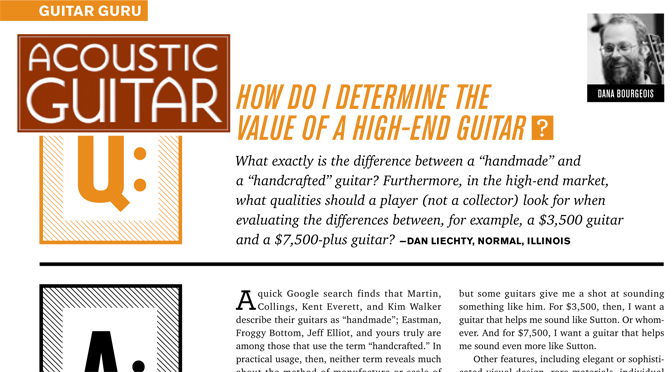Guitar Guru
Guitar Guru – High End Value
Dana Bourgeois contributes the monthly Guitar Guru column to Acoustic Guitar Magazine. If you a question you’d like Dana to address in an upcoming article, please submit it to [email protected].
Download the PDF of this article here
HOW DO I DETERMINE THE VALUE OF A HIGH-END GUITAR
Q:
A: A quick Google search finds that Martin, Collings, Kent Everett, and Kim Walker describe their guitars as “handmade”; Eastman, Froggy Bottom, Jeff Elliot, and yours truly are among those that use the term “handcrafted.” In practical usage, then, neither term reveals much about the method of manufacture or scale of operation.
But that answer’s probably not very satisfying. Surely, how a guitar is made must have some bearing on quality, right? Unfortunately, that loaded question can’t be fully explored within the scope of this column. Perhaps, though, by riffing on your second question, some light can be shed on the first.
I’ve always felt that a guitar should first be judged by its ability to make music in the hands of an accomplished player. Players, though, come in all levels of ability. I can’t play like Bryan Sutton, but some guitars give me a shot at sounding something like him. For $3,500, then, I want a guitar that helps me sound like Sutton. Or whomever. And for $7,500, I want a guitar that helps me sound even more like Sutton.
Other features, including elegant or sophisticated visual design, rare materials, individual customization, or a luthier’s skillful and painstaking use of hand tools, can add further layers of value. Like beauty, though, value is in the eye of the beholder. If non-musical features pluck your strings, you should include these in your overall assessment of value. But don’t confuse the icing with the cake. If you don’t feel qualified to fully evaluate the musical potential of a guitar, seek the opinions of the best players you know.
So this kinda loops back to the handmade question.
Some of the most valuable fretted instruments ever made were produced by so-called factories. A 1939 Martin D-28 or D-45, as well as a 1923 Gibson F-5 mandolin, were each built by many hands, using at least some heavy machinery and employing certain semi-automated processes. Today, these instruments have far greater market value than most other instruments of similarly beautiful design and similarly superb craftsmanship. This is because popular, influential, and culturally significant music was once made on them, and continues to be.
I once wrote that I’ve never been moved to tears by an inlay, a fret job, a beautifully executed finish, or even a piece of wood. Music is an altogether different story. A guitar’s reason for being is to function as a musical instrument. It can also be an art object, but that’s a separate and, I would argue, secondary function. If you buy a guitar for playing music, make sure it provides you with enjoyable musical experiences. And that includes giving you, the player, something always to reach for, even if you’re Bryan Sutton.

